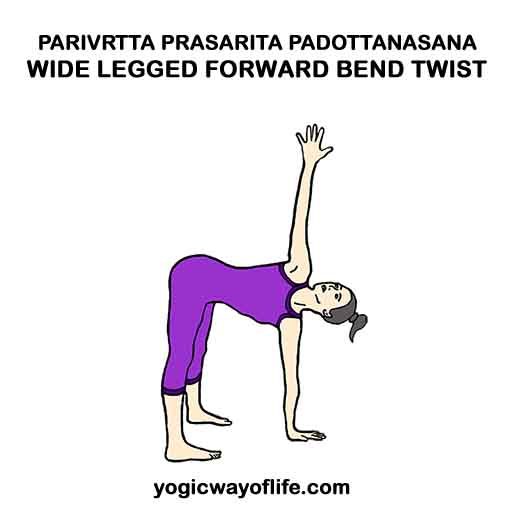Parivrtta Prasarita Padottanasana or the Wide-Legged standing forward bend twisted pose is a stretching posture along with the twist of the upper body. This Asana improves digestion, relaxes the body and gives a sense of balance. In Sanskrit, Parivrtta means revolved or twisted, Prasarita means spread out, Pada means feet and Asana is a pose.
How to do Parivrtta Prasarita Padottanasana?
- Stand on the floor and place the hands on the hips.
- Spread your legs about 3 – 4 feet apart.
- Inhale and expand the chest and raise the neck.
- Exhale and slowly bend forward along the hips. Keep going forward till your hands touch the floor.
- Balance yourself on both the hands for a moment. Normally in this position the knees should not be bent to get maximum stretch of the hamstrings and calf muscles. But if you find it difficult, you may bend the knees a little to ease the position.
- Take your left hand and move it towards the ceiling, with palms straight and pointing upwards.
- Turn the head and gaze upwards, towards the right palm.
- Maintain this position for as long as you are comfortable.
- To release the pose, bring down the right hand to the floor and the slowly come up to the standing pose with hands on the hips. Bring the two legs together and rest.
- The pose can be repeated on the other side also, with the right hand facing upwards.
Benefits of Parivrtta Prasarita Padottanasana
- Parivrtta Prasarita Padottanasana stretches and strengthens the hamstrings, thighs and calf muscles.
- It strengthens the muscles of the upper body and shoulders.
- It improves digestion by toning the organs in the abdomen.
- It releases stress in the shoulders and neck muscles.
- It gives a good relaxation to the body and mind.
- It can relieve mild depression.
- This asana also gives a good sense of physical balance.
Contraindications for Parivrtta Prasarita Padottanasana
- This pose should be avoided by those who have any injury of the knees, hips, shoulders, neck, ribs and back muscles.
- Those who had any recent surgery of neck, shoulders, abdomen or legs should avoid this asana.

